Sant Llorenç de la Muga
 Sant Llorenç de la Muga is a small town situated in on the Muga river in the hills that rise behind Figueres to the French border and is a real find. The town with its old bridge, well-preserved centre and town gates complete with portcullis entrances is complemented with a tower, castle and walks into the pine woods along the river.
Sant Llorenç de la Muga is a small town situated in on the Muga river in the hills that rise behind Figueres to the French border and is a real find. The town with its old bridge, well-preserved centre and town gates complete with portcullis entrances is complemented with a tower, castle and walks into the pine woods along the river.
It's difficult to explain, but as you leave Figueres and pass through Llers into pre-Pyrenees the landscape seems to change dramatically within just a few kilometres. From the broad Empordan plain that stretches to the sea, suddenly you are in deep wooded valleys with high peaked hills and behind them views of the snows on Canigou. The trees are pine, instead of the lower Alzina and cork oaks nearer the coast, and the fields along the bottom of the valley are cultivated with crops rather than the olive groves of the drier fields of the Albere mountains that you would find closer to La Jonquera.
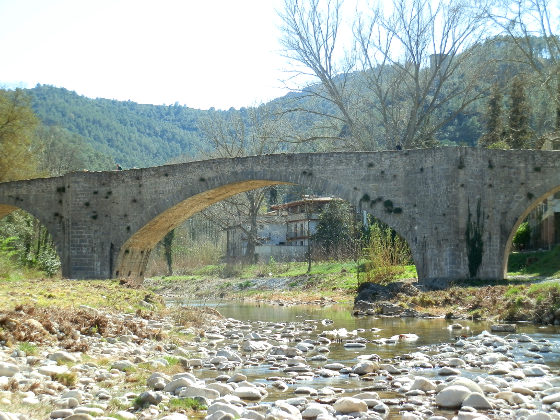
The town of Sant Llorenç de la Muga is found on a single in-and-out road that leads to Albanya and the Gorges de la Muga (which we intend to get to in summer). However, despite its relative remoteness the town is very well renovated and preserved, attracting French tourists from across the nearby border.
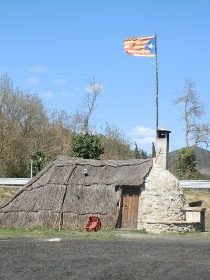 For this walk we arrive and park in the first parking area, just before the new road bridge, and right next to the old original stone bridge that crosses the Muga.
For this walk we arrive and park in the first parking area, just before the new road bridge, and right next to the old original stone bridge that crosses the Muga.
In the vicinity of the parking, down towards the river is a odd house clad in reeds or wood almost like thatch - something we've never seen in Catalonia - and it's not clear if it is a house or a working building as there are scattered remains of charcoal in a circle outside.
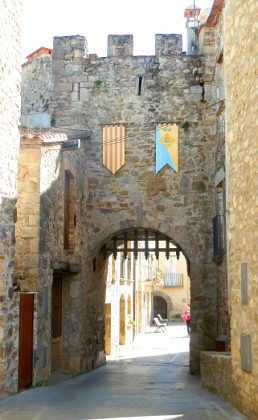 After taking photos of the old bridge from the new bridge, we cross the old bridge into town. The bridge is a classic cobblestone bridge with clear shallow Muga river bubbling over the rocks and stones below and we can already see the church and the watchtower that stands above the town.
After taking photos of the old bridge from the new bridge, we cross the old bridge into town. The bridge is a classic cobblestone bridge with clear shallow Muga river bubbling over the rocks and stones below and we can already see the church and the watchtower that stands above the town.
We head towards the town centre to explore a little. The first thing we come to is a town gate with portcullis in place, just beside the safareig (communal village laundery or wash place - very common in Catalonia towns) beside a smooth running stream.

The portal gate leads into the main part of town, two small plaças and stone walled medieval houses that look as if they could have been built yesterday. Our tour of the centre discovers more gates, all with portcullis in place, and a large square in front of the ajuntament with French speaking visitors taking lunch on the terrace of one of the local restaurants.
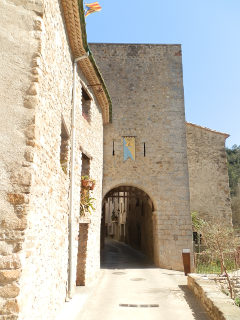 Leaving one of the town gates we find a strange triangular bridge over the river that seems to lead up to the watchtower above the town. Keeping it in mind, we return via the next gate to see the church - almost two churches actually - one older in front of the newer clock tower.
Leaving one of the town gates we find a strange triangular bridge over the river that seems to lead up to the watchtower above the town. Keeping it in mind, we return via the next gate to see the church - almost two churches actually - one older in front of the newer clock tower.
We now follow the river, crossing it on an older bridge just below the triangular bridge so our dog doesn't have to cross the metal gridded floor which is uncomfortable for her paws.
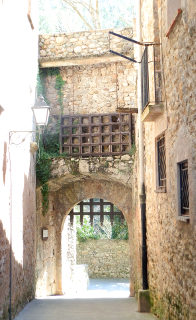 On the other side of the river there are a series of flagstone steps and pathway that climbs up to the tower. From the top we have a grand vista of the town and the river valley below, and out to the higher hill peaks in the distance.
On the other side of the river there are a series of flagstone steps and pathway that climbs up to the tower. From the top we have a grand vista of the town and the river valley below, and out to the higher hill peaks in the distance.
From the tower, we take the track at the back down, rather than the way we came. This gently follows the rough direction of the river past a telephone mast, and then down through the pine woods and white blossomed shrubs and budding deciduous trees enjoying the spring sun.
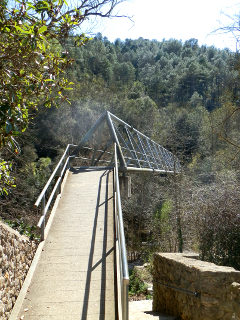 At the bottom we pass a masia farm then arrive back at the river, just by a second old stone bridge. This time we can here music and rushing water and we can see a family swimming and picnicking in a water pool beside a waterfall close to the Ermitage de Sant Antoni. Its March, so it's surprising to see people swimming, but the water looks lovely - deep and clear, particularly under the bridge itself.
At the bottom we pass a masia farm then arrive back at the river, just by a second old stone bridge. This time we can here music and rushing water and we can see a family swimming and picnicking in a water pool beside a waterfall close to the Ermitage de Sant Antoni. Its March, so it's surprising to see people swimming, but the water looks lovely - deep and clear, particularly under the bridge itself.
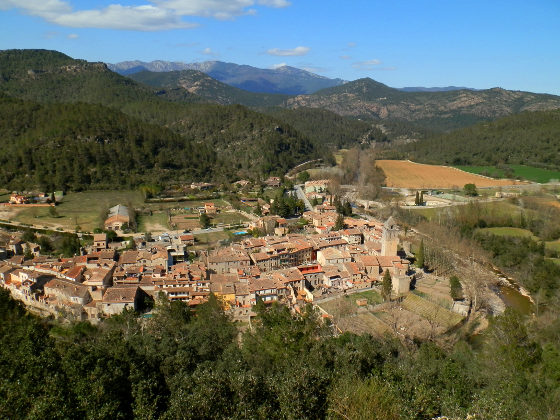
 Instead of returning towards town, we carry on out taking the path past the small number of houses and out back into the woods above the river valley.
Instead of returning towards town, we carry on out taking the path past the small number of houses and out back into the woods above the river valley.
After about 3km we take the path down towards the river, past another farmhouse and find ourselves with a ford and long-step stepping stones to cross the river.
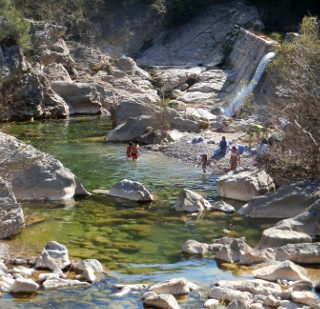 To make the loop back, we want to avoid the road - which is quiet, but we prefer to be off the tarmac, so we head up a track into the hill, climbing steadily at quite a puff. The first junction right takes us down on the far side of the hill and we follow the path steadily back down to an urbanisation close to Sant Antoni bridge. As we go down we pass more French tourists on a walk themselves.
To make the loop back, we want to avoid the road - which is quiet, but we prefer to be off the tarmac, so we head up a track into the hill, climbing steadily at quite a puff. The first junction right takes us down on the far side of the hill and we follow the path steadily back down to an urbanisation close to Sant Antoni bridge. As we go down we pass more French tourists on a walk themselves.
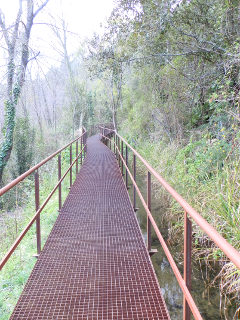 To connect back to town there is a path just beneath the road, which you find if you cross the road close to the Ermitage. Though it's close to the road it is quite separate and there is no road noise, and good views of the river.
To connect back to town there is a path just beneath the road, which you find if you cross the road close to the Ermitage. Though it's close to the road it is quite separate and there is no road noise, and good views of the river.
Eventually this path arrives at a metal gridded path/platform that runs above a millstream water channel for about 200m - the water clear with fish and water boatmen underneath the metal grid. It would be lovely, except for carrying our dog (who seems a little heavier than we remember).
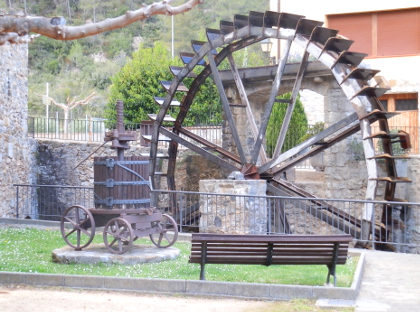 Eventually we reach steps at the bottom of an old castle - privately owned, so not visitable, but right next door is a working waterwheel powered by the mill stream we just walked above and along.
Eventually we reach steps at the bottom of an old castle - privately owned, so not visitable, but right next door is a working waterwheel powered by the mill stream we just walked above and along.
From here we connect back into town meandering back to the car park. A lovely walk and town that surprised us, but has already got us thinking about going back to explore further up the valley.
Nearby: Lladó (between Figueres and Besalu) - Figueres and Castell de Sant Ferran - Waterfall at Les Escaules (Boadella) - Espolla to Rabos - La Jonquera to Fort de Bellegarde (France) - Sadernes and river pools of St Aniol d'Aguja - Castell de Requesens (Cantallops) - Sant Llorenç de la Muga
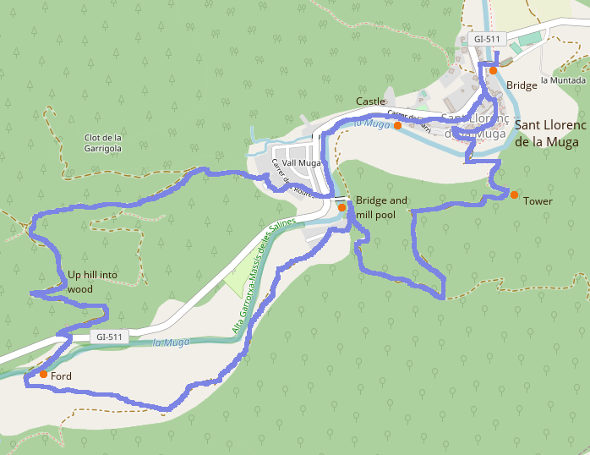

 Walks and other things
Walks and other things